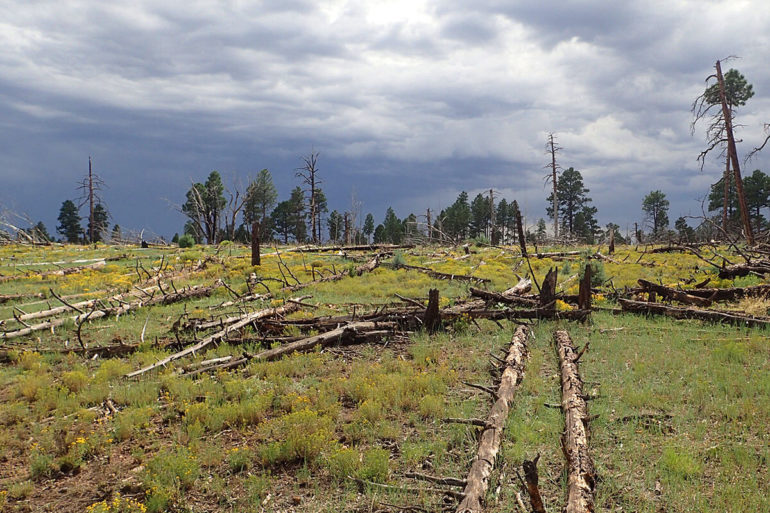New University of Montana research suggests recurring continent-spanning drought patterns set the tempo for forest recovery from wildfire.
A study published Nov. 9 in the Proceedings of the National Academy of Sciences shows that forest recovery from fire follows a drought seesaw, called a climate dipole, that alternates between the Northwest and the Southwest every few years.
The researchers examined the relationship between this drought seesaw and post-fire regeneration of ponderosa pine across the Interior West of the U.S. They found that severe droughts under climate change are making it increasingly difficult for tree seedlings to regenerate after fire.
“Managers and scientists are increasingly concerned that western forests won’t be able to recover from wildfire under hotter and drier conditions,” said Caitlin Littlefield, the study’s lead author. “Forest recovery hinges on the success of tree seedlings, which are particularly vulnerable to drought. We wanted to explore how patterns in drought variability across the western U.S. affect post-fire tree regeneration to better understand where and when we can predict robust recovery—or lack thereof.”
The authors used annual ponderosa pine regeneration data from a previous UM study led by Kimberley Davis, as well as U.S. Forest Service inventory data. They examined the relationship between ponderosa pine regeneration and the dynamics of the dipole.
When the dipole is active, conditions in the Southwest may be relatively moist while the Northwest region is dry—or vice versa. Ponderosa pine regeneration in each region tracks the seesaw, with greater regeneration success in the relatively moist region and greater seedling mortality in the relatively dry region. The situation switches on average every three to four years.
The importance of this drought variability on ponderosa pine regeneration endures for years post-fire. These results highlight a critical window of opportunity for forest recovery within the first few years after fire.
Moreover, the results show that regeneration is declining overall due to increasing aridity across the Western U.S.
“Forest recovery in the Northwest, including the Northern Rockies, is in some ways intrinsically linked to what happens in the Southwest, even if in an opposing direction, through this large-scale, recurring drought pattern,” Littlefield said. “The record-setting climatic conditions of 2020 offer a perfect example: It was relatively cool and moist in the Northern Rockies and hot and dry in the Southwest. This enabled the extraordinary wildfire activity we’ve witnessed. The opposite occurred in the summer of 2017, when Western Montana saw record drought and a record fire year, while the Southwest was relatively mild. In each of these places the drought will affect regeneration success after fire in the short- and long-term.”
Littlefield said that in some ways, the drought pattern resembles a seesaw on an elevator.
“The Northwest and the Southwest alternate in terms of where there’s drought and where there’s not—that’s the seesaw,” Littlefield said. “But overall, aridity is increasing and making it increasingly hard for tree seedlings to regenerate in both regions—that’s the elevator. It’s important that we get a handle on these patterns so that we can anticipate the impacts of climate change,” she said. “We’re losing millions of acres of forest to wildfire each year, and that trend isn’t likely to stop. But I’m glad that policymakers are increasingly recognizing the dire need for dry forest restoration and post-fire replanting, and I hope this sort of research can help us develop the best strategies for promoting forest recovery.”
Littlefield is a recent postdoctoral researcher in the W.A. Franke College of Forestry and Conservation and is now a researcher at the University of Vermont. Other UM co-authors include Solomon Dobrowski and Davis. Co-authors also include John Abatzoglou from the University of California, Merced, and Sean Parks of the Aldo Leopold Wilderness Research Institute located at UM.
The study, “A Climatic Dipole Drives Short- and Long-term Patterns of Post-fire Forest Recovery in the Western United States,” is available online.
Thinning and prescribed fire treatments reduce tree mortality
More information:
Caitlin E. Littlefield et al. A climatic dipole drives short- and long-term patterns of postfire forest recovery in the western United States, Proceedings of the National Academy of Sciences (2020). DOI: 10.1073/pnas.2007434117
Provided by
University of Montana
Citation:
Study reveals patterns that shape forest recovery after wildfires (2020, November 10)
retrieved 10 November 2020
from https://phys.org/news/2020-11-reveals-patterns-forest-recovery-wildfires.html
This document is subject to copyright. Apart from any fair dealing for the purpose of private study or research, no
part may be reproduced without the written permission. The content is provided for information purposes only.



